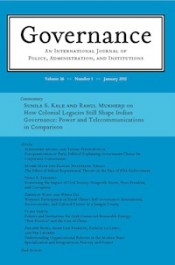Disability reform in the Netherlands: How did it happen?
By Jan-Maarten van Sonsbeek and Raymond Gradus. In the 1990s and in the beginning of this century, disability benefit rates in the Netherlands were among the highest in the world. Since then, the number of disability cases has dropped by more than 60% due to some very successful policy reforms such as the introduction of a new disability benefit law (WIA) in 2006.
In a recent article in Governance, Paulette Kurzer investigates how such a major reform was possible. She argues that it was against all odds: it was done by the center-right Balkenende II cabinet in times of economic growth with fierce opposition of the social partners (trade unions and employers organizations). She puts forward that many voters were not opposed to reform anymore because they learned about the high benefit rates of immigrants, whom they consider not deserving a benefit.
In our opinion, there are some key elements missing in Kurzer’s analysis. First, the 2006 law was not the reform that overshadows all others. Second, unlike the author states, the circumstances for pushing through the WIA reform were good in the early 2000s. Third, the supposed link between acceptance of the reforms by the voters and the attitude of the voters towards ethnic minorities is not so strong as Kurzer suggests. In our opinion, the key element why the WIA law succeeded whereas some earlier system reforms failed, was the smart design of that law.
The 2006 WIA law was the last of a series of successful reforms of the Dutch disability benefit scheme. In our paper “Estimating the effects of recent disability reforms in the Netherlands” (forthcoming in Oxford Economic Papers; already available online), we show that experience rating introduced in 1998 has reduced inflow into the WAO scheme by 13 percentage points and the introduction of the gatekeeper protocol in 2002 has further reduced inflow by 25 percentage points. The additional effect of the new WIA law results in a decrease of inflow by 21 percentage points. This series of reforms by subsequent cabinets shows that there was a broad consensus in Dutch society that the disability scheme somehow had to be reformed.
The system reform in 2006 was not against all odds. The idea for the new law was put forward by a commission of experts from all important political parties in 2001. It recommended that maintenance and use of the available labor capacity of benefit claimants should have the highest priority, and that the main responsibility for ensuring this rests with both employers and employees. In 2002, the social partners agreed upon the core elements of the commission’s proposal. In 2003, the new Balkenende II government, which started in times of economic decline, proposed the new law based on this agreement. The disagreements between government and social partners concerned details of the new law, mainly on the benefit level of the permanently, fully disabled and the use of experience rating for this group. Major disagreements between government and social partners did occur in 2004, but primarily concerned the reform of the early retirement scheme. In short, the WIA law was proposed by a united government with - on the key elements of the law - support of social partners.
The supposed link between acceptance of the reforms by the voters and the attitude of the voters towards ethnic minorities is weak. By the end of 2000, the government for the first time reported on the use of social security benefits by ethnic background. However, although the numbers, showing extremely high proportions of beneficiaries among older Turkish and Moroccan immigrants, caused a lot of publicity, to voters it was a mere confirmation of something they already knew. Accordingly, the opinion of Dutch voters on the broad system of social security did not change a lot in the early 2000s.
Of course, the issues of multiculturalism and integration of ethnic minorities were very prominent in the Netherlands since the rise of Pim Fortuyn in 2002, but these discussions did not really extend to the (perceived) abuse of disability benefits by ethnic minorities. Illustratively, although Pim Fortuyn had strong opinions on reforming disability insurance (without making references to the benefit use of immigrants), during the 2002 election campaign he supported the agreement of the social partners on reform.
When searching for a reason why the new law was so easily accepted by the general public, it is interesting to compare it to an earlier major system reform in 1993, similar in impact to the WIA, that failed due to massive resistance of society. A key factor in the acceptance of the 2006 law may have been its smart design. It distinguishes between the most severely disabled and the less severely disabled, providing a safe and generous benefit for the former. The 1993 reform on the other hand, was more generic and therefore also hurt the most severely disabled. This lack of targeting caused a lot of negative publicity, forcing the new cabinet to relax the 1993 reforms. This conclusion on the importance of the design of a new law may hold important lessons for other countries discussing social security reforms.
Dr. Jan-Maarten van Sonsbeek is head of the Social Funds Unit of UWV, the Employee Benefits Agency of the Netherlands, and researcher at VU University Amsterdam. (Email: jan-maarten.vansonsbeek@uwv.nl) Raymond Gradus is professor of Public Economics at VU University Amsterdam and director of the Research Institute for the CDA.

